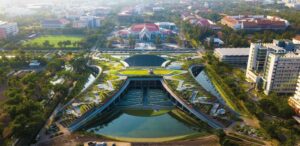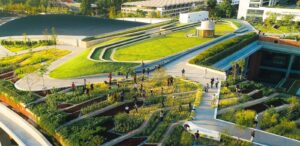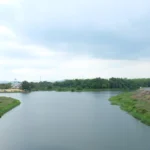Bangkok, Thailand | Green Infrastructure for Climate Resiliency
Bangkok, Thailand
Date: June 12, 2023

Fast Facts
- Mayor: Chadchart Sittipunt
- Population: 5,490,000
- Area: 1,568,737 km
- GCoM Signatory since 2023
- The capital city of Thailand and the heart of commerce and culture also marks the only cosmopolitan city in Thailand.
- Bangkok has the longest city name in the world which translates to “the City of Gods, the Great City, the Residence of the Emerald Buddha, the Impregnable City (of Ayutthaya) of God Indra, the Grand Capital of the World Endowed with Nine Precious Gems, the Happy City Abounding in Enormous Royal Palaces Which Resemble the Heavenly Abode Wherein Dwell the Reincarnated Gods, a City Given by Indra and Built by Vishnukarm.”[1]
Background

Bangkok is a metropolitan coastal city. With more than 5 million population residing in the area, 140 skyscrapers, and 700 buildings are surrounded by waters between the low-lying Chao Praya Delta and the Bay of Bangkok[2]. Those conditions become vulnerable when Bangkok’s population grows, and rapid urban development makes the only coastal metropolitan city in Thailand prone to the impacts of climate change. One of the biggest concerns from Bangkok will be the sea level rise where waters near the Bangkok area are rising 1.2 cm per year and estimate will erode 1.3 km of land annually due to the heavy groundwater extraction and construction. This situation project that Bangkok is sinking and projection from IPCC estimate that 96% of Bangkok will sink by 2030. Bangkok as a coastal city is subject to land subsidence[3] and various challenges, such as high precipitation and flooding risk, Bangkok needs to take immediate action to increase city resiliency against climate change.
Solutions Implemented
- Bangkok Metropolitan Administration and Bangkok Metropolitan Region have collaborated since 1983 to build dikes in preventing water discharge from tides and waterways in urban areas.
- Following the 2011 Flood disaster, the government enacted a 500 million baht-worth of infrastructure programme to build diversion and drainage tunnels, a retention pond, and a water expressway to increase the city’s capacity in facing floods.
- The establishment of Chulalongkorn Centenary Park in 2017 which could collect 1 million gallons of water became a pivotal green infrastructure to reduce urban flood risk[4].
- Thammasat Green Roof the largest Asia Urban Rooftop Farm was established in 2019. This initiative incorporates modern architecture and traditional agriculture practice that brings regenerative impact to nature. This facility was built on an unused rooftop in Bangkok and has been revived into climate change solutions. The Thammasat Green Roof act as a nature-based solution where this facility could collect 11,718 Cubic meters or 3,095,570 gallons of water which will be utilised for growing crops.[5] The green roof is also beneficial for the animals to take refuge, increase biodiversity with its crop, and produce oxygens from the trees.

Results and Solutions Learned
Initiatives taken by Bangkok’s local government through infrastructure procurement and collaboration with experts in increasing the city’s capability and adaptation against climate change impact have resulted in positive impacts. The nature-based solutions that revived unused facilities into the urban forest and green areas bring benefits to the environment and society. Multifunctional facilities, such as Chulalongkorn Centenary Park become pedestrian spots for leisure time as well as a retention pond that collect rainwater and prevent flooding, also the Thammasat Green Roof in providing food and reviving the biodiversity of nature. Those initiatives become a success story where climate action shall leave no species behind and incorporating modern technology with traditional practice indeed bring the best outcome for both aspects of sustainability and human comfort.
There is still an ongoing agenda where land subsidence due to topography and excessive water extraction are still happening.[6] Actions through engineering and policy-making have been done where drainage and water management system capacity is being increased and enforcing policy in limited groundwater extraction has been imposed. However, the issue is still there and the government is doing its best in decreasing the casualties. The way forward on the vulnerability is for government to maintain their actions and ensure their progress to achieve the target on groundwater extraction reduction and shall collaborate with the community in succeeding the initiatives.
[1] Lawrence Sternstein, “Bangkok | Location, History, Population, Map, & Facts,” Encyclopedia Britannica, June 1, 2023, from https://www.britannica.com/place/Bangkok
[2] Pratch Rujivanarom, “Bangkok is still sinking, and fast!” Bangkok Post, February 6, 2023. https://www.bangkokpost.com/thailand/general/2499786/bangkok-is-still-sinking-and-fast-
[3] Manon Dangelser, Bangkok, Thailand 2022 Exploring Urban Resilience Pathways, City Resilience Design and Management, 2022, https://masterurbanresilience.com/wp-content/uploads/2022/06/UIC-Bangkok-Report_2021_2022_MD.pdf
[4] UNFCCC, Nature-Based Solutions to Increase Urban Adaptability | Thailand, UNFCCC, n.d., https://unfccc.int/climate-action/momentum-for-change/women-for-results/nature-based-solutions
[5] Damian Holmes, “Thammasat University – the largest urban rooftop farm in Asia,” World Landscape Architecture, January 13, 2020, https://worldlandscapearchitect.com/thammasat-university-the-largest-urban-rooftop-farm-in-asia/?v=3a1ed7090bfa
[6] N. Phien-wej, P. Giao, P. Nutalaya, “Land subsidence in Bangkok, Thailand,” Engineering Geology, 82(4), (2006): 187-201, https://doi.org/10.1016/j.enggeo.2005.10.004





